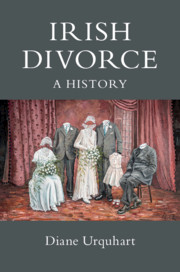Book contents
- Irish Divorce
- Irish Divorce
- Copyright page
- Dedication
- Contents
- Figures
- Acknowledgements
- Introduction: The ‘Anatomy of a Divorce’
- 1 Divorce in Two Legislatures: Irish Divorce, 1701–1857
- 2 The Failings of the Law: The Cases of Talbot and Westmeath
- 3 A Non-Inclusive Reform: Ireland and the Divorce and Matrimonial Causes Act of 1857
- 4 Divorce in the Post-Reform Era of 1857–1922: ‘Like Diamonds, Gambling, and Picture-Fancying, a Luxury of the Rich’
- 5 The Widening Definition of Marital Cruelty
- 6 Divorce in Court, 1857–1922
- 7 ‘An Exotic in Very Ungenial Soil’: Divorce in the Northern Ireland Parliament, 1921–1939
- 8 With as ‘Little Provocation as Possible’: The Northern Ireland Move to Court
- 9 An ‘Unhappy Affair’: Divorce in Independent Ireland, 1922–1950
- 10 Marriage Law ‘in This Country Is an Absolute Shambles’: The Reform Agenda
- 11 A ‘Curiosity [and] … an Oddity’: Referenda in 1986 and 1995
- 12 The ‘Last Stretch of a Long Road’: The Family (Divorce) Law Act of 1996
- Conclusion
- Bibliography
- Index
2 - The Failings of the Law: The Cases of Talbot and Westmeath
Published online by Cambridge University Press: 16 January 2020
- Irish Divorce
- Irish Divorce
- Copyright page
- Dedication
- Contents
- Figures
- Acknowledgements
- Introduction: The ‘Anatomy of a Divorce’
- 1 Divorce in Two Legislatures: Irish Divorce, 1701–1857
- 2 The Failings of the Law: The Cases of Talbot and Westmeath
- 3 A Non-Inclusive Reform: Ireland and the Divorce and Matrimonial Causes Act of 1857
- 4 Divorce in the Post-Reform Era of 1857–1922: ‘Like Diamonds, Gambling, and Picture-Fancying, a Luxury of the Rich’
- 5 The Widening Definition of Marital Cruelty
- 6 Divorce in Court, 1857–1922
- 7 ‘An Exotic in Very Ungenial Soil’: Divorce in the Northern Ireland Parliament, 1921–1939
- 8 With as ‘Little Provocation as Possible’: The Northern Ireland Move to Court
- 9 An ‘Unhappy Affair’: Divorce in Independent Ireland, 1922–1950
- 10 Marriage Law ‘in This Country Is an Absolute Shambles’: The Reform Agenda
- 11 A ‘Curiosity [and] … an Oddity’: Referenda in 1986 and 1995
- 12 The ‘Last Stretch of a Long Road’: The Family (Divorce) Law Act of 1996
- Conclusion
- Bibliography
- Index
Summary
A case-study approach of two Irish cases in the mid-1850s drew popular attention to the vulnerability of women under the existing gendered law of divorce and the need for its reform. The 1856 divorce of John Talbot of Co. Roscommon and Mary Anne (néeMacCausland) of Co. Londonderry was highly publicised. The case also raised popular criticism of Talbot for conspiring to be rid of his wife, the ecclesiastical courts and parliamentary divorce. The case coincided with a lunacy panic regarding the incarceration of sane women in asylums; however, in the Talbot case, Mary Anne never regained her sanity after being detained and subjected to a physical and likely sexual attack to allow her spouse to divorce her on the grounds of adultery. This divorce attracted considerable legal attention and prompted calls for divorce to be removed from the parliamentary arena. The Westmeaths, even after decades of litigation, never secured a divorce. A re-reading of Emily, Marchioness of Westmeath, is presented here to restore her to the historical narrative as a divorce law reformer and challenge Stone’s earlier sexist portrayal of her as petty, vindictive and obsessed with women’s rights.
Keywords
- Type
- Chapter
- Information
- Irish DivorceA History, pp. 44 - 62Publisher: Cambridge University PressPrint publication year: 2020



